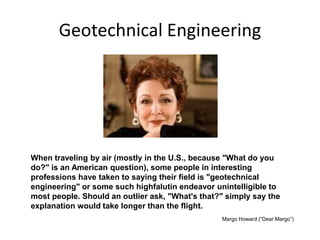The Basic Principles Of Geotheta
The Basic Principles Of Geotheta
Blog Article
See This Report about Geotheta
Table of ContentsGeotheta for Beginners4 Easy Facts About Geotheta ExplainedThe 2-Minute Rule for GeothetaGeotheta for DummiesGeotheta Fundamentals Explained

They conduct website investigations, accumulate samples, do research laboratory examinations, and evaluate data to examine the suitability of the ground for construction jobs - Consulting Engineers. Based on their searchings for, geotechnical designers provide referrals for structure style, incline stability, maintaining structures, and mitigation of geotechnical hazards. They team up with various other professionals, such as architects, architectural engineers, and construction teams, to guarantee that geotechnical factors to consider are incorporated right into the general task style and application
By analyzing the habits and homes of dirt and rock, they can identify possible geotechnical threats such as landslides, dirt settlement, or slope instability. Their expertise aids protect against failures or mishaps that could jeopardize lives and property. Below are some detailed duties and duties of a geotechnical designer: Website Examination: Geotechnical designers conduct website examinations to gather information on subsurface problems.
They analyze the information to recognize the homes and behavior of the dirt and rock, including their strength, permeability, compaction features, and groundwater conditions. Geotechnical Analysis and Layout: Geotechnical engineers examine the information gathered during website examinations to analyze the security and suitability of the website for construction jobs. They do geotechnical estimations and modeling to evaluate elements such as birthing ability, negotiation, slope stability, lateral earth pressures, and groundwater flow.
Some Of Geotheta
Structure Design: Geotechnical designers play a vital function in creating structures that can safely support the intended framework. They assess the dirt problems and tons requirements to establish the proper structure type, such as shallow foundations (e.g., grounds), deep structures (e.g (https://www.slideshare.net/ianhammond2191)., piles), or specialized techniques like soil enhancement. They consider elements such as settlement limitations, bearing capability, and soil-structure communication to create ideal structure designs
They review building strategies, display site activities, and perform area examinations to confirm that the layout referrals are followed. If unexpected geotechnical problems arise, they evaluate the circumstance and provide referrals for removal or changes to the layout. Threat Analysis and Mitigation: Geotechnical designers evaluate geotechnical threats and threats connected with the project website, such as landslides, liquefaction, or soil disintegration.

Cooperation and Interaction: Geotechnical engineers function carefully with other specialists involved in a job, such as architects, architectural engineers, and construction teams. Efficient communication and collaboration are necessary to integrate geotechnical considerations right into the general task style and building and construction process. Geotechnical engineers supply technological proficiency, response queries, and ensure that geotechnical requirements are satisfied.
The Ultimate Guide To Geotheta
Right here are some types of geotechnical designers: browse around these guys Structure Engineer: Foundation designers concentrate on developing and examining foundations for frameworks. They assess the dirt conditions, load needs, and site qualities to establish the most proper structure type and layout, such as superficial structures, deep structures, or specialized techniques like heap foundations.
They examine the factors affecting incline stability, such as soil residential properties, groundwater problems, and incline geometry, and develop approaches to stop slope failures and minimize threats. Quake Engineer: Earthquake engineers focus on examining and developing structures to withstand seismic forces. They assess the seismic threat of a website, review soil liquefaction potential, and establish seismic layout requirements to ensure the safety and strength of frameworks throughout quakes.
They do field screening, collect samples, and assess the gathered information to define the dirt homes, geologic formations, and groundwater conditions at a site. Geotechnical Instrumentation Designer: Geotechnical instrumentation engineers concentrate on monitoring and gauging the actions of soil, rock, and structures. They install and preserve instrumentation systems that check variables such as soil settlement, groundwater degrees, incline activities, and structural variations to examine efficiency and give very early cautions of possible concerns.
What Does Geotheta Do?
They carry out tests such as triaxial examinations, debt consolidation tests, straight shear examinations, and leaks in the structure tests to gather data for geotechnical analysis and layout. Geosynthetics Engineer: Geosynthetics designers concentrate on the layout and application of geosynthetic materials, such as geotextiles, geogrids, and geomembranes. They make use of these materials to enhance dirt stability, reinforce inclines, supply water drainage solutions, and control erosion.
They have a tendency to be investigative people, which means they're intellectual, reflective, and inquisitive. They are curious, systematic, sensible, analytical, and logical. A few of them are likewise social, indicating they're kind, charitable, cooperative, patient, caring, valuable, empathetic, tactful, and pleasant. Does this audio like you? Take our complimentary profession test to learn if geotechnical engineer is among your top career matches.
In the office setting, geotechnical designers make use of specialized software program tools to perform computations, produce designs, and evaluate data. They prepare records, testimonial task requirements, communicate with customers and employee, and coordinate task tasks. The workplace setup offers a conducive setting for research study, evaluation, and collaboration with other specialists included in the job.
Facts About Geotheta Uncovered
They regularly go to job websites to perform site examinations, assess geotechnical conditions, and collect information for evaluation. These brows through entail traveling to different places, sometimes in remote or tough terrains. Geotechnical designers might perform soil tasting, conduct examinations, and screen building tasks to make certain that the geotechnical facets of the project are being executed properly.
Geotechnical engineers likewise operate in specialized geotechnical laboratories. In these centers, they carry out experiments, execute tests on soil and rock samples, and examine the engineering buildings of the materials. Geotechnical research laboratory designers function thoroughly in these settings, handling screening devices, running instruments, and videotaping information. They collaborate with other lab personnel to ensure exact and trustworthy screening outcomes.
Report this page